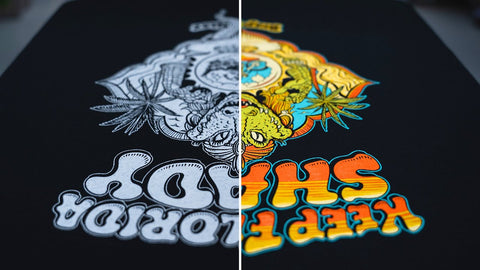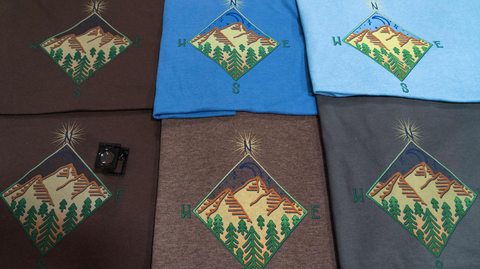New screen printers should start off printing with plastisol ink. It's more forgiving than water-based ink and it's much easier to achieve proper cure. Even though printing plastisol is more straightforward, there are many techniques to print the ink for various processes. We've created a collection of videos and blogs that explain how to print with plastisol ink in different situations.

5 COMMONLY ASKED QUESTIONS ABOUT FN-INK PLASTISOL INK
FN-INK™ is a low-cure plastisol ink that prints like a dream and doesn’t hurt your wallet. All inks are different, so using FN-INK™ might take a little bit of experimenting. Got questions? In this blog, we’ll answer five most commonly asked questions about FN-INK™.
READ THE FULL POST

HOW TO SCREEN PRINT WHITE PLASTISOL INK ON A DARK GARMENT USING A SMOOTHING SCREEN
Printing white ink on a dark garment is not a simple task. Screen printing genius Colin Huggins goes over best practices for printing white plastisol ink on a black shirt. Got a notebook and pencil handy? Right, let's learn how to print white ink on a dark garment and make the print as bright and clean as possible.
WATCH THE VIDEO

HOW TO PROPERLY CURE PLASTISOL INK WITH A FLASH DRYER
A flash dryer is a versatile piece of equipment and can be used in many ways, no matter how small your shop is. Curing with a flash dryer takes a little bit of experience to dial in, but can be another way to cure prints without a conveyor dryer. In the video, Josh Wells walks you through properly curing garments with a flash dryer.
WATCH THE VIDEO

HOW TO ACHIEVE SOFT-HAND PRINTS USING PLASTISOL INK
Want soft-hand prints? Print with water-based inks.
Well, water-based printing isn't accessible to every printer. Luckily, there are some things you can do to make your plastisol prints softer. Between the inks you choose to use, the garments you're printing on, to the available ink additives, achieving soft plastisol prints is very possible. Let's take a look to see how to accomplish this goal.
READ FULL POST

FOUR WAYS TO PRINT BLACK PLASTISOL INK ON BLACK SHIRTS
Printing black ink on a black shirt — trendy, right? As with everything in screen printing, there are multiple ways to achieve this goal. From using a puff base to printing with clear base to curing at higher and lower temperatures, printers can offer a variety of effects and looks to their customers. Let's take a look to see how each technique turns out so you can decide what's best for your next print job.
WATCH THE VIDEO

4 WAYS TO SCREEN PRINT WHITE PLASTISOL INK ON A WHITE SHIRT
One cool technique printers can have fun with is tonal prints. You’ve probably heard of—or maybe even printed—black ink on black shirts, blue ink on blue shirts, red ink on red shirts, and the list goes on. One tonal print that’s often overlooked is white ink on white shirts. Printing white ink on white shirts is different and unique, producing awesome effects. Let’s talk about a few different methods of printing white ink on a white shirt.
WATCH THE VIDEO

HOW TO MAKE PLASTISOL HEAT TRANSFERS
Screen printing heat transfers can seem daunting but in reality, it’s fairly simple. If made properly, plastisol heat transfers can last almost as long as a standard screen print and can be much easier to apply in certain scenarios like decorating hats, neck labels, names for sport apparel, and more.
Let's walk through the basic components and process of screen printing your own heat transfers.
WATCH THE VIDEO

HOW TO SCREEN PRINT MULTI-COLOR PLASTISOL HEAT TRANSFERS
Heat transfers are useful for many reasons. You can use transfers for live events, brand shirts with neck labels, and for customers who order in low volume but order consistently over time. Creating a one-color transfer is a simple process. Things get complicated when you add multiple colors. In the video, print expert Colin Huggins walks you through how to create the best multi-color plastisol heat transfers.
WATCH THE VIDEO

EVERYTHING YOU NEED TO KNOW TO SCREEN PRINT AN UNDERBASE
Knowing how to screen print an underbase is crucial for screen printers. If you want a bright, vivid print, you'll need to lay down a solid white base. Rogue Lab Owner Lee Stuart breaks down the steps on how to achieve a fantastic underbase.
WATCH THE VIDEO

ENSURING PROPER INK CURING
Curing your prints is one of the last steps of the screen printing process, but it is one of the most important steps. Ink needs to be cured properly so it sets into the garment. If the ink does not cure fully, it will crack, fall apart, and not last for long. Printers use either heat guns, heat presses, flash dryers, or conveyor dryers to cure inks. Let's take a look at how each curing device works.
READ FULL POST

HOW TO HANDLE PLASTISOL INKS IN COOLER TEMPERATURES
Dreaming about warm summer days when your ink flows oh so smoothly? Winter and its cooler temperatures sure makes it difficult for a screen printer, especially with white plastisol inks. The ink feels thick, stringy, and stiff. It requires more effort to lay down a good ink deposit. Does it have to be this hard? Nope. Ink and Chemistry Guru Colin Huggins shares his secrets to making white plastisol ink easier to handle during the cooler months.
READ FULL POST

HOW TO PRINT BLACK PLASTISOL INK ON A WHITE GARMENT
We learned about printing white plastisol ink on a black shirt, but what about black plastisol ink on a white shirt? In our latest video, expert Colin Huggins explores the nuances of printing black plastisol ink on light-colored garments.
WATCH THE VIDEO

HOW TO ACHIEVE MATTE OR GLOSSY PRINTS
Wondering how to adjust the final looks of the ink? (Is it too shiny? Want it to look dull? Or is it dull and you want it to look shiny?) Let's look into it.
READ FULL POST

HOW TO SCREEN PRINT A VINTAGE LOOK
Vintage prints have been a popular design choice for a long time. You can create a vintage print by taking a design and deliberately making that design look lighter on the garment so that the shirt color is influencing it but it also looks aged and worn. Want to learn how? Print expert Josh Wells walks you through the process.
WATCH THE VIDEO

HOW TO SCREEN PRINT WET ON WET HALFTONES AND COLOR BLENDS FOR A VINTAGE LOOK
Remember when expert Colin Huggins showed how to create halftones and blends in Adobe Illustrator? Now he's printing that design. Watch to learn how to print wet-on-wet halftones and blends, tips to get the best colors and blends, and how shirt colors affect the look of the print.
WATCH THE VIDEO

UNLOCK ANY COLOR WITH THE FN-INK PLASTISOL INK MIXING SYSTEM
Printers have loved how easy it is to print FN-INK™, how bright and vibrant colors are, how soft a print feels. With the addition of a Mixing White and Magenta, the FN-INK™ Mixing System allows printers to unlock an endless amount of colors while maintaining their favorite features.
Interested? Let’s look at why a printer would even need an ink mixing system, how to use FN-INK™’s system, and color matching.
READ THE FULL POST

WHAT'S THE DIFFERENCE BETWEEN A MIXING WHITE AND REGULAR WHITE INK?
Is it really necessary to have a mixing white? What’s the difference between a mixing white ink and regular white plastisol ink? Can you use a regular white to mix inks? Print expert Colin Huggins talks about the differences and why printers want a mixing white in their ink arsenal.
READ THE FULL POST

WHAT IS COLOR SHIFT AND WHY DOES IT CHANGE THE COLOR OF MY INKS?
Color Shift is based on color theory. If you have ever printed a color, checked the print, and noticed it turned out different than you expected? That is called color shift. It will happen with every ink you print. Depending on a few key factors, you can end up with one color looking completely different than you anticipated. Let's look at the different variables at play and show you how to make adjustments to deal with color shift both before press and on press.
WATCH THE VIDEO

WANT TO CREATE A CUSTOM BROWN INK? HERE'S HOW
If you’ve tried to search for a bucket of brown ink, you might notice the selection is limited. If you do find an out-of-bucket brown ink, it might not be the exact color you had in mind. To get the perfect shade of brown you’re imagining, you’ll have to mix it custom. Let’s talk about mixing your own brown ink to get the best results.
READ THE BLOG

HOW TO USE A PMS MIXING SYSTEM TO MIX CUSTOM GRAY INK COLORS
Gray is a popular color for screen printing. It’s great for printing neck tags and looks good on many colors of garments. Printers who choose gray for a design’s color scheme usually have to mix it themselves. Ink manufacturers may not carry a ready-to-print gray. If they do, there’s a chance it won’t be the shade you’re looking for. Good thing for mixing systems, right? Here’s how to mix your own perfect shade of gray screen printing ink.
READ THE BLOG

PRINTING WITH PLASTISOL VS. WATER-BASED INK
Screen printers debate which is better: plastisol or water-based ink. Some printers start out with plastisol ink, while others opt to jump right into water-based printing. But how are they different? Why would you use one over the other? Ink master Colin Huggins lays out the differences and nuances to printing each type of ink. You’ll be able to decide which ink is best for your shop.
READ THE BLOG

HOW TO ENSURE PLASTISOL INK IS READY FOR PRODUCTION
Plastisol ink is a popular ink choice. From beginner to auto shops, plastisol ink is a game changer. But do you know when it’s really ready to use? Do you find yourself pulling out a glob of ink thick enough to rival cement? Here’s how to be sure it’s ready for production.
WATCH THE VIDEO

THE ADVANTAGES OF PRINTING WITH PLASTISOL INK
Print shops all over the world debate whether water-based ink or plastisol ink is the better option. There are advantages and drawbacks to both types of ink. The ink you choose to print with depends on your shop setup and goals for your prints. Let’s talk about the advantages of printing with plastisol ink.
READ THE BLOG

THE LOWDOWN ON LOW CURE PLASTISOL INK
Been looking at FN-INK™? Did you just get it? You probably have a million questions about the plastisol ink: what’s different, best practices for using it, and more. Well, fasten your seatbelts folks. We’re going to guide you through everything you need to know about using FN-INK™.
READ THE BLOG

UNLOCK SPECIALTY PRINTING WITH 7 INKS FROM FN-INK
What’s better than having a low-cure, ready-to-print plastisol ink that’s also a mixing system? One that’s got specialty inks and additives to make your prints as creative as you are. With seven new additions to the FN-INK™ line, the possibilities are endless. Want to know what these new specialties are all about? Let’s jump in.
READ THE BLOG

TIPS FOR PRINTING PUFF PLASTISOL INK ADDITIVE TO ACHIEVE HIGH DETAIL DESIGNS
There’s no doubt that Puff ink is awesome. It’s a favorite for printers of all types because it can be added to so many different types of prints. Whether the design is block text or fine-line detail, Puff makes it stand out. How much detail can you achieve with Puff? Print expert Colin Huggins wants to find out.
WATCH THE VIDEO

HOW TO CREATE A HEAT MAP FOR SCREEN PRINTING USING PUFF ADDITIVE
Do you know where the sweet spot is on your flash dryer? Every flash unit has an area that gives off the most consistent heat. How do you find out where that is? Print expert Colin Huggins has a solution: creating a heat map using puff ink. Let’s find out how he does it.WATCH THE VIDEO

EVERYTHING YOU NEED TO KNOW TO SCREEN PRINT ON SPANDEX GARMENTS
Sometimes you need to print on stretchy fabrics. Think leggings, jerseys, athletic clothing, and more. Stretchy clothes are likely to have Spandex, or Lycra, in them. In order to print on ultra-stretchy garments with plastisol ink, you’ll need a special tool in your arsenal: FN-INK™ Stretch. Let’s talk about everything you need to know to print on Spandex and Spandex-blended garments.
READ THE BLOG

HOW STRETCH PLASTISOL INK CAN BE USED AS A FOIL ADHESIVE
Foil is a great way to make prints shimmer without using another screen for metallic ink. It brings out details in designs with reflective qualities and can look spectacular if done right. Generally, a unique foil adhesive is used for decorating shirts with foil. But stretch plastisol ink can work in a pinch. Print experimenter Ronald Peters tests it out.
WATCH THE VIDEO

Here’s a question: what is dye migration? You’ve heard of it, maybe you’ve even experienced it. But what really is dye migration, and how does it affect your garments? Let’s talk about how dye migration occurs and how you can prevent it from happening on your next job.

